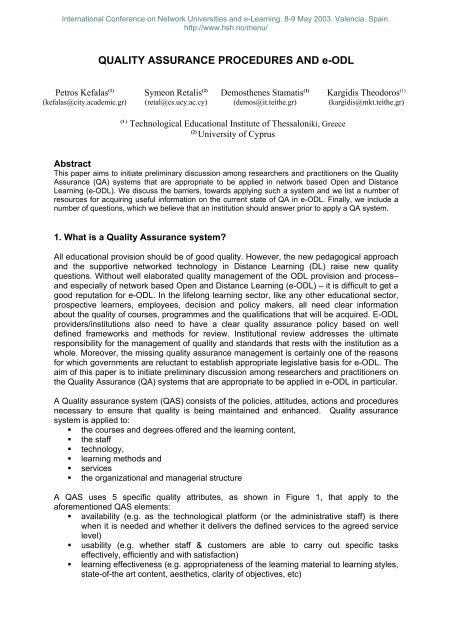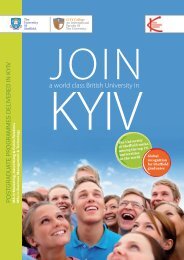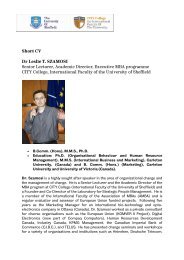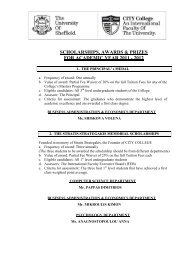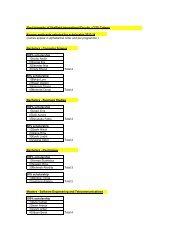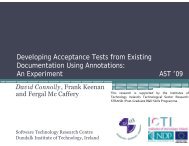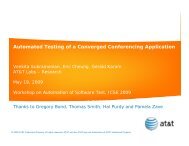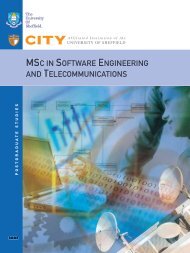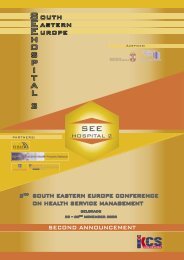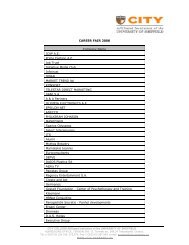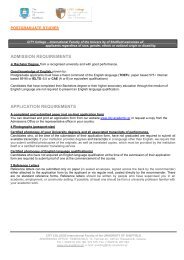QUALITY ASSURANCE PROCEDURES AND e-ODL - City College
QUALITY ASSURANCE PROCEDURES AND e-ODL - City College
QUALITY ASSURANCE PROCEDURES AND e-ODL - City College
Create successful ePaper yourself
Turn your PDF publications into a flip-book with our unique Google optimized e-Paper software.
<strong>QUALITY</strong> <strong>ASSURANCE</strong> <strong>PROCEDURES</strong> <strong>AND</strong> e-<strong>ODL</strong>Petros Kefalas (1)(kefalas@city.academic.gr)Symeon Retalis (2)(retal@cs.ucy.ac.cy)Demosthenes Stamatis (1)(demos@it.teithe.gr)Kargidis Theodoros (1)(kargidis@mkt.teithe.gr)(1 )Technological Educational Institute of Thessaloniki, Greece(2)University of CyprusAbstractThis paper aims to initiate preliminary discussion among researchers and practitioners on the QualityAssurance (QA) systems that are appropriate to be applied in network based Open and DistanceLearning (e-<strong>ODL</strong>). We discuss the barriers, towards applying such a system and we list a number ofresources for acquiring useful information on the current state of QA in e-<strong>ODL</strong>. Finally, we include anumber of questions, which we believe that an institution should answer prior to apply a QA system.1. What is a Quality Assurance system?All educational provision should be of good quality. However, the new pedagogical approachand the supportive networked technology in Distance Learning (DL) raise new qualityquestions. Without well elaborated quality management of the <strong>ODL</strong> provision and process–and especially of network based Open and Distance Learning (e-<strong>ODL</strong>) – it is difficult to get agood reputation for e-<strong>ODL</strong>. In the lifelong learning sector, like any other educational sector,prospective learners, employees, decision and policy makers, all need clear informationabout the quality of courses, programmes and the qualifications that will be acquired. E-<strong>ODL</strong>providers/institutions also need to have a clear quality assurance policy based on welldefined frameworks and methods for review. Institutional review addresses the ultimateresponsibility for the management of quality and standards that rests with the institution as awhole. Moreover, the missing quality assurance management is certainly one of the reasonsfor which governments are reluctant to establish appropriate legislative basis for e-<strong>ODL</strong>. Theaim of this paper is to initiate preliminary discussion among researchers and practitioners onthe Quality Assurance (QA) systems that are appropriate to be applied in e-<strong>ODL</strong> in particular.A Quality assurance system (QAS) consists of the policies, attitudes, actions and proceduresnecessary to ensure that quality is being maintained and enhanced. Quality assurancesystem is applied to:• the courses and degrees offered and the learning content,• the staff• technology,• learning methods and• services• the organizational and managerial structureA QAS uses 5 specific quality attributes, as shown in Figure 1, that apply to theaforementioned QAS elements:• availability (e.g. as the technological platform (or the administrative staff) is therewhen it is needed and whether it delivers the defined services to the agreed servicelevel)• usability (e.g. whether staff & customers are able to carry out specific taskseffectively, efficiently and with satisfaction)• learning effectiveness (e.g. appropriateness of the learning material to learning styles,state-of-the art content, aesthetics, clarity of objectives, etc)
• performance (e.g. institution’s ability to perform tasks within certain constraints in timeand resources)• security (e.g ability to respond to a threat, protection of intellectual property right andpersonal details)• potential for change (e.g. institution’s ability to retain of increase its values to anenterprise)availabilityusabilityperformancepotential for changequality attribute1..nusesexercises1securityapplies toapplies tocourse1..n1ENUapplies toquality assurance systemEuropean Master Degree study programmelanguageapplies toapplies to applies tocontentstucturestudy plancontenttechnologymethodsFigure 1. The ENU QASservicesThus the QAS is called to check the following quality criteria:• curricular learning effectiveness (availability, appropriateness to learning styles, stateof-theart content, clarity of objectives, etc)• academic staff teaching, research and development achievements• flexibility of organisation allowing credit transfer, interdisciplinarity, studying within theframework of various programmes or institutions;• usability of infrastructure and availability of adequate equipment (e.g. ISO standard)• protection (security) of personal data• accountability with regard to the use of human and material resources• positive feedback from the students and responsiveness to their suggestions,proposals, and critique;• positive feedback and support from stakeholders and labour-market needs• international scientific competitiveness;• promising strategic planning with respect to international policies• the capacity for changeSo the question that need to be asked is how to measure the quality criteria and with whichtoolkits? ENU QAS should give an answer to this question!
2. Barriers in implementing QASThe main obstacles in implementing a QAS are:• the incompatibility of assessment and QA systems between institutions and countriesin Europe.• the lack of a generally accepted QA system in Europe for traditional mode of delivery• the lack of a generally accepted QA system in Europe for e<strong>ODL</strong> mode of delivery• the lack of a generally accepted QA system in Europe for joint programmes, i.e.developed by more than one institution.In terms of a diagrammatical sketch, a proposal for a QA system could the one illustrated inFigure 2:Figure 2. A proposal for a European QAS for e-<strong>ODL</strong>The problem is that some of the QA systems (those in dotted line boxes) in the abovediagram do not exist. The e-<strong>ODL</strong> QA should make sure that it is flexible enough to stretchand get in line with those QA which will arise in the future either at National or Europeanlevel.Related to the above is the acceptance of ECTS as the main credit system at EuropeanLevel, which removes another barrier towards QA, which is the incompatibility of coursedesign.3. Brief Overview of QA SystemsA useful overview of QA can be found in [2]. QA systems, irrespectively of mode of deliveryshould be able to demonstrate that:• Learning outcomes have been set at the appropriate level and clearly communicated tothe students• Content and design of the curriculum and the teaching methodologies employed areeffective in enabling the student to achieve the outcomes in terms of both theacquisition of knowledge and the development of related practical skills and abilities• Assessment is appropriately designed and rigorously administered to measure theachievement of the outcomesIt is also mentioned that essential components of a quality course are:• Clearly defined and achievable learning objectives• Relevant, scholarly and up to date curriculum content• Well designed teaching and learning materials• Well supported total learning package
• Sound technical design• Appropriate and necessary personnel support• Provision of access to additional learning resources• Planned resource provision• Outline overview and evaluation cycle.In Europe, some countries have established QA guidelines for their institutions. For example,in the UK, there are two bodies; the Quality Assurance Agency for Higher Education (QAA)and the Open and Distance Learning Quality Council (<strong>ODL</strong>QC).The QAA lists the guidelines on QA of DL as follows [9]:• System design• Establishment of Academic Standards and Quality in Programme design, Approval andReview Process• Assurance of Quality and Standards in the management of Programme delivery• Student Development and Support• Student Communication and Representation• Student AssessmentThe <strong>ODL</strong>QC [8] categorises the criteria for QA (and possibly accreditation) as follows:• Course Objectives and Outcomes• Course Contents• Publicity and Recruitment• Admission Procedures• Learning Support• Open Learning Centers• Learner Welfare• Provider Organisation• Joint Provision• AccreditationAt European level, there are no specific attempts to define QA criteria and measures for e-<strong>ODL</strong>. We could mention the effort of CRE and EUA on:• Accreditation schemes for Higher Education in Europe [3]• Survey on Master Degrees and Joint Degrees in Europe [4]respectively.In the US and other countries, the situation is much alike in Europe, although the scope ofDL has already been integrated in some bodies that issue guidelines for QA. For example,the Institute for Higher Educational Policy (IHEP) lists the following key benchmarks for thequality e-<strong>ODL</strong> [12]:• Institutional Support• Course development• Teaching / Learning• Course Structure• Student Support• Faculty Support• Evaluation and AssessmentIn the US alone, many different bodies are established, each one of which represents agroup of Universities and <strong>College</strong>s, such as Southern Association of Schools and <strong>College</strong>s(SACS), Council for Higher Education Accreditation (CHEA) etc. A short review on thecurrent state in US, including all those bodies can be found in [7]. The report states the bestpractices and the criteria for QA:
• Curriculum and Instruction: Learning and Content, Interactions,Assessment/measurement, Tools and Media• Learning Support Systems and Services• Faculty and faculty Support• Library and Learning Services• Student Services and Information• Programme Planning, Evaluation and Assessment4. Issues for Discussion when applying a QAS at European LevelThis section includes a list of questions for discussion that will eventually lead to choosingand application a QA system for e-<strong>ODL</strong> programmes. In many of the questions posed below,there is a demand of uniform and commonly accepted policy among institutions (worldwide ifpossible). This does not necessarily imply uniformity in practice. We believe that the mostimportant issue in convergence is to interpret “uniform” as “non-contradicting”. This issuemainly arises due to the variety of pedagogical, administrational, organizational, technical,managerial, etc. policies of e-<strong>ODL</strong> institutions Europe wide.The questions can be classified into the following categories:General:• Is there a significant difference between traditional mode and e-<strong>ODL</strong> mode in terms ofquality criteria?Administrative Level:• Is there a clear Mission Statement?• Is there a viable Strategic Plan?• Is there a provision for termination?• Is there an effective and clear Administrative Structure?• Is there a clear allocation of tasks in the Administrative staff?• Is there a provision for compatibility with legislation in all EU countries involved?• Are there any admissions criteria?• Who is responsible for conflict resolution?Programme Design level:• Is the programme designed according to some commonly accepted criteria?• Is there a consultation of professional bodies that affect the decisions made for thecurriculum?• What are the overall aims and objectives of the programme?• What are the overall learning outcomes of the programme?• What is the degree awarded?• Is there a provision for those who will complete part of the programme?• What are the regulations leading to the award of the degree?• How does the programme compare to traditional mode of delivery equivalentprogrammes?Course Design Level:• Is there a commonly accepted credit system?• How do courses relate to other courses of the programme?• Is there a clear structure in the content of each course?• Is there a clear separation between course elements?• Are there contradictory designs between various courses?
• How does a course design compare to traditional mode of delivery equivalent coursedesign?Course Delivery:• Is there a commonly accepted policy on the method of <strong>ODL</strong> course delivery?• What is the process of selecting methods of delivery?• Do these methods effectively and efficiently exploit information technologies?• How easy or difficult is to follow the selected method?• Does the method of delivery contribute to the fulfillment of learning objectives?• Are there clear instructions for students concerning method of delivery?Course Assessment:• Is there a commonly accepted policy on the method of <strong>ODL</strong> course assessment?• Is there a commonly accepted marking scheme?• What are the individual parts of assessment in each course?• What is the process of selecting the appropriate assessment?• Does assessment contribute to the fulfillment of learning objectives?• Does assessment correspond to workload (credits)?• Are there specific marking criteria for each individual piece of assessment?• Is the student informed about the assessment criteria and marking scheme?• Is there provision for timely feedback? What is the form of feedback?• Are there clear examination procedures?• Are there effective ways in place to identify impersonation and plagiarism?Students:• Is there a commonly accepted policy on keeping student records?• Is there a policy regarding privacy and security of personal data?• Are students well informed about the ENU, admissions criteria, award of degree,programme, courses, exam procedures, regulations, etc?• Do students get the appropriate support for course content and technologicalinfrastructure?• Do students get the appropriate services in technology required? Is there provision forthis support to be continuous?• How do student get support for autonomous learning?• Do student get the appropriate service from the administration?• Do student receive advising and encouragement?• Is there provision for student representation?• Is there a complaint or appeal mechanism in place?• Is there a mechanism for student evaluation of courses and programme?• How is the progress of students monitored?Staff:• Is there a commonly accepted staff recruitment policy?• Is there a commonly accepted staff development policy?• Is there a commonly accepted staff appraisal policy?• What are the criteria, characteristics and profile of academic staff selected to deliver<strong>ODL</strong> courses?• What are the criteria characteristics and profile of technical staff selected to support<strong>ODL</strong> course delivery?• Is there provision for continuous staff training?• How is staff evaluated?• Is there a provision for training of new staff?• How is staff encouraged to improve own teaching, research and scholarship?
Other Resources:• What are the technical resources required for e<strong>ODL</strong>?• Is there a commonly accepted platform for e<strong>ODL</strong>?• What kind of Library resources can be utilized?• Do the selection and use of eLibraries comply with copyright legislation?• Are the selected resources easy and effective to use?Review:• Are there sufficient processes and procedures for review of programme, courses etc?• Is there a self-assessment review in place?• Is there any possibility for external review?• How is best practice disseminated within the institution, among staff etc.?• How would the student feedback be incorporated in the review?• How would the market feedback be incorporated in the review?• What are the procedures of applying modifications?• How often a review should be contacted?• Are there any provisions for changing the organization structure?AcknowledgementsThis research is connected to the Minerva project “MENU: A Model for a European NetworkUniversity” (project reference number: No 2002 – 0510 / 001 – 001 EDU – ELEARN). This project hasbeen carried out with the support of the European Community in the framework of the e-LEARNINGINITIATIVE Socrates programme. The MENU project homepage is: http://www.hsh.no/menuReferences[1] Haugen H., Ask B., Hjeltnes T., The European E-Learning Initiative, IASTED InternationalConference, Computers and Advanced Technology in Education, 2002[2] Hope A. Quality Assurance, In: The Changing faces of Virtual Education, The Commonwealth ofLearning, 2001[3] CRE, TOWARDS ACCREDITATION SCHEMES FOR HIGHER EDUCATION IN EUROPE?http://www.unige.ch/cre/activities/accreditation/report-FINAL_doc_1.pdf[4] European University Association EUA, Survey on Master Degrees and Joint Degrees in Europe,http://www.unige.ch/eua/En/Publications/Survey_Master_Joint_degrees.pdf[5] Southern Association of Schools and <strong>College</strong>s SACS, http://www.so.cc.va.us/vccsit/Quality.pdf[6] Southern Regional Education Board SREB,http://www.electroniccampus.org/policylab/Reports/Quality%20Assurance%20Draft_LG.pdf[7] Review of Recommended Quality Assurance Standards for Distance Education,www.academic.com/academic_com/library/Distance_Ed.pdf[8] Open and Distance Learning Quality Council, Standards in Open and Distance Learning,http://www.odlqc.org.uk/odlqc/st-int.htm[9] Quality Assurance Agency for Higher Education, Guidelines on the Quality Assurance of DistanceLearning, http://www.qaa.ac.uk/public/dlg/dlg_textonly.htm[10] Council for Higher Education Accreditation, http://www.chea.org[11] Western Interstate Commission for Higher Education WICHE,http://www.wiche.edu/Policy/PolicyInsights/Distance%20Education/pol2opt.htm[12] Institute for Higher Educational Policy, Quality on Line, http://www.ihep.com/Pubs/PDF/Quality.pdf


